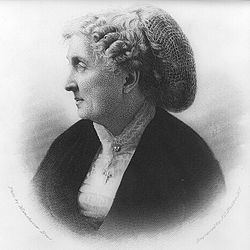Full Name Paulina Kellogg Name Paulina Wright | Spouse Thomas Davis (m. 1849) | |
 | ||
Born August 7, 1813 ( 1813-08-07 ) Bloomfield, New York, US Occupation Suffragist
Abolitionist
Educator Died August 24, 1876, Providence, Rhode Island, United States Books A History of the National Woman's Rights Movement for Twenty Years : with the Proceedings of the Decade Meeting Held at Apollo Hall, October 20, 1870, with an Appendix Containing the History of the Movement During the Winter of 1871, in the National Capitol Parents Ebenezer Kellogg, Polly Saxton | ||
Paulina Kellogg Wright Davis | Wikipedia audio article
Paulina Kellogg Wright Davis (August 7, 1813 – August 24, 1876) was an American abolitionist, suffragist, and educator. She was one of the founders of the New England Woman Suffrage Association.
Contents
Early life
Davis was born in Bloomfield, New York to Captain Ebenezer Kellogg and Polly (Saxton) Kellogg. The family moved to the frontier near Niagara Falls in 1817. Both her parents died, and in 1820 she went to live with her orthodox Presbyterian aunt in Le Roy, New York. She joined the church, although she found it hostile to outspoken women. She wanted to become a missionary but was unable to as the church did not allow single women to become missionaries.
Later life
She was courted by suitor Francis Wright, a merchant from a prosperous family from Utica, New York; they married in 1833. They had similar values and both resigned from their church to protest its pro-slavery stance and served on the executive committee of the Central New York Anti-Slavery Society. In 1835, Davis and her husband organized an anti-slavery convention in Utica. They also supported women's rights reforms, associating with Susan B. Anthony, Elizabeth Cady Stanton and Ernestine Rose. During this period Davis studied women's health. Francis Wright died in 1845; the couple had no children.
Following her husband's death she moved to New York to study medicine. In 1846 she gave lectures on anatomy and physiology to women only. She imported a medical mannequin and toured the eastern United States teaching women and urging them to become physicians. In 1849 she married Thomas Davis, an Irish-American Democrat from Providence, Rhode Island; they adopted two daughters.
In 1850 she started to focus her energies on women's rights. She stopped lecturing and helped to arrange the first National Women's Rights Convention in Worcester, Massachusetts, at which she presided and delivered the opening address. Except for one year, she was president of the National Woman's Rights Central Committee from 1850 to 1858. In 1853, she began editing the women's newspaper The Una, handing over the responsibility to Caroline Wells Healey Dall in 1855.
Davis was one of the founders of the New England Woman Suffrage Association in 1868. When the group splintered, Davis and Susan B. Anthony became involved in the National Woman Suffrage Association. In 1870 she arranged the twentieth anniversary of the Women's Suffrage Movement meeting, and published The History of the National Woman's Rights Movement.
Death and legacy
Davis died on August 24, 1876, in Providence, Rhode Island. She was eulogized by Elizabeth Cady Stanton.
She was inducted into the National Women’s Hall of Fame in 2002. In 2003, she was inducted into the Rhode Island Heritage Hall of Fame, along with her husband.
